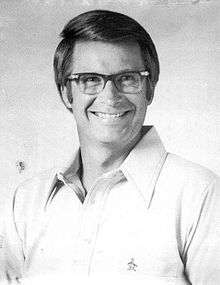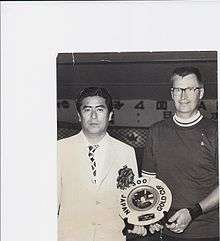Earl Anthony
Earl Roderick Anthony (April 27, 1938 – August 14, 2001) was a left-handed American professional bowler who amassed records of 43 titles and six Player of the Year awards on the Professional Bowlers Association (PBA) Tour. For over two decades, his career title count was listed as 41. The count was amended to 43 in 2008, when the PBA chose to retroactively award PBA titles for ABC Masters championships if won by a PBA member at the time.[1] He is widely credited (along with Dick Weber) for having increased bowling's popularity in the United States. He was the first bowler to earn over $100,000 in a season (1975), and the first to reach $1,000,000 in lifetime PBA earnings (1982). His ten professional major titles—six PBA National Championships, two Firestone Tournament of Champions titles, and two ABC Masters (now USBC Masters) titles—are the second most all time, tied with Pete Weber and three behind Jason Belmonte.[2][3]
Earl Anthony | |
|---|---|
 Earl Anthony, 1979 | |
| Born | Earl Roderick Anthony April 27, 1938 |
| Died | August 14, 2001 (aged 63) |
| Years active | 1963-1997 |
| Height | 6 ft 1 in (185 cm) |
| Bowling Information | |
| Affiliation | PBA |
| Rookie year | 1970 |
| Dominant hand | Left |
| Wins | 43 PBA Tour (10 majors) |
| Sponsors | Brunswick |
Never brash or flashy in a crew-cut and plastic-frame "marshwood" style eyewear (which he abandoned for more modern frames later in his career), Anthony was dubbed "Square Earl" by fellow pro bowlers.[4]
A new biography of Earl (focusing more on his bowling career but with a few personal insights) was published in October 2019 by Luby Publishing. Compiled by sportswriter Barry Sparks, it is titled Earl: The Greatest Bowler of All Time.
PBA career
Anthony's bowling career began when he hesitantly joined his company's bowling league, West Coast Grocery, after serving in the United States Air Force. After his first season bowling, Earl achieved his first official league bowling average of 165. By his third season, his average had surged to 217. In 1963, he bowled three PBA summer tournaments in the Pacific Northwest to get a feel for what it would take to successfully compete on the tour. Though he did not cash in any of the three events, he had succeeded in learning how much he would need to improve before he could entertain any idea of going out on the PBA Tour full-time. In order to prepare himself for the tour Anthony practiced between 300-350 games a week, up to eight hours day, and often without any pins (in order to save money). After six years of diligent practice Anthony began his professional bowling career in January 1970, leading the tournament going into the televised finals at Crestview Bowl in Wichita, Kansas. He lost the championship match to Skee Foremsky, finishing in second place. [5]
Anthony won the first of his 43 PBA titles on June 7, 1970, when he defeated Allie Clarke at the Heidelberg Open in Seattle, Washington. His final PBA title was a major — the 1983 Toledo Trust PBA National Championship. Six of his titles were achieved by a pair of improbable "three-peats" in the PBA National Championship, the first three from 1973–75 and the other three from 1981–83. Earl also finished runner-up to fellow lefty Mike Aulby in the 1979 PBA National Championship.
After a nine-month layoff, Anthony won his second ABC Masters tournament in 1984, which at the time was not part of the PBA Tour.[6] Anthony had also won the Masters in 1977. The PBA later added ABC Masters titles as PBA titles, giving Anthony at least one PBA title in 15 consecutive seasons (1970–84). He joined the Senior Tour in 1988 and accumulated another seven titles there.[4]
By 1988 Anthony had 25 career 300 games.[7] Sadly, not one was on television in the United States; he did, however, bowl two televised 299 games, leaving a solid 9-pin on the last shot in one and a 6-pin on the other. Although he didn't drop to the floor like Don Johnson, Anthony would remark about the 9-pin on a PBA telecast years later, saying, "to this day, I can't believe that pin stood." Earl Anthony did shoot a televised 300 game on national TV in a PBA Tournament in Japan in front of over 50 million viewers.

After retiring, Anthony moved to the broadcast booth as a color commentator[8] and operated a bowling center in Dublin, California.[4]
Personal life and death
Anthony was born in Tacoma, Washington to Earl Anthony and Laura Davis. He was a minor league baseball pitcher with the Baltimore Orioles organization before his days as a professional bowler. He was also an excellent golfer, achieving a near-scratch handicap at the age of 60. He once set the course record at Crow Canyon Country Club in Danville, California with a scratch score of 64.


He was married to Susie Anthony; and had a son, Mike, and two daughters, Tracy and Jeri.[9]
Anthony missed some time on the PBA Tour during the 1978 season after suffering a heart attack in June of that year. Less than three months later he was back on Tour, finishing third in the Waukegan (IL) Open.[6]
Earl Anthony died in 2001, succumbing to head injuries suffered after falling down a flight of stairs at his friend Ed Baur's home in New Berlin, Wisconsin. He was 63 years old.[4][10]
The "Earl Anthony Memorial Scholarship Fund" was established through funding by the ABC Championship Tournament, in order to provide scholarships to young bowlers. It is now administrated by the Bowling Foundation.
In January 2002, the PBA began the year with a tournament named after Anthony, "The Earl Anthony Memorial Classic." It was first held at TechCity Bowl in Kirkland, Washington. It was won by left-handed pro bowler Parker Bohn III, who beat Patrick Healey, Jr. in the final match 235 to 215. It later moved to Medford, Oregon and re-titled as "The Earl Anthony Medford Classic." In 2010 and 2011, the event took place in Dublin, California and was titled the Earl Anthony Memorial.
Legacy
Anthony was voted into the PBA Hall of Fame in 1981 and the ABC Hall of Fame in 1986.[11] In 2000 he was voted "Master of the Millennium" by a wide margin in a nationwide vote conducted by Bowling Magazine.[12] In a Sports Illustrated Magazine national vote he was named the 2nd Greatest Athlete in the history of the State of Washington (behind only former Gonzaga and NBA star John Stockton).[13]
The late bowling legend Dick Weber dubbed Anthony "the greatest speed-control bowler ever."[4] When Anthony won the 1978 Tournament of Champions to become the first bowler to ever reach 30 titles, Weber was in the broadcast booth and proclaimed Anthony to be "the undisputed King of Bowling."[14] Earl's record of 41 titles stood for 23 years before it was broken by Walter Ray Williams Jr. in 2006,[15] though it increased to 43 in 2008 when the PBA started including ABC Masters titles if they were won by a PBA member.[16] In 14 seasons, Anthony made the top five for the televised final round a record 144 times. Said Bowlers Journal editor Jim Dressel, "When Earl was in the house, everybody else knew there were only four other spots for TV."[6]
In 2008, the PBA celebrated fifty years in existence by commissioning a panel of experts to rank the "50 Greatest Bowlers of the Last 50 Years." Anthony was ranked #1 on the list over Walter Ray Williams Jr., despite the fact that Williams had broken many of Anthony's records. However, Williams himself said, "I feel Earl's record is better than mine because it was more condensed. Earl bowled 14 years and 400 or so events. I’ve bowled well over 600 by now, maybe 700."[17] Williams also added, "When Earl Anthony retired, he didn't have anyone to push him. He probably would have kept going to 50 if that were the case. It's hard to say what would've happened then."[18]
Awards and recognition
- Six-time BWAA Bowler of the Year (1974–76 and 1981–83)
- Six-time PBA Player of the Year (1974–76 and 1981–83)[7]
- Twelve-time First Team All-American (1972-83)
- Five-time George Young High Average award winner (1973–75, 1980, 1983)
- Established a record for most consecutive PBA seasons winning at least one tournament (15), which stood until 2008 when it was broken by Walter Ray Ray Williams Jr.
- Holds PBA record of 15 televised finals appearances in one season (1975, 1981)
- Holds a record six wins in the PBA National Championship among his ten major tournament titles
- Inducted into PBA Hall of Fame, 1981
- Inducted into ABC (now USBC) Hall of Fame, 1986
- Voted "Bowler of the Millennium" in a 2000 poll conducted by Bowling Digest[19]
- Voted the greatest PBA player ever, when the PBA announced its "50 Greatest Players of the Last 50 Years" list in the 2008-09 season.
References
- All-time title leaders at www.pba.com
- Goldstein, Richard (16 August 2001). "Earl Anthony, 63, Bowling's First $1 Million Man, Dies". The New York Times. Retrieved 26 September 2010.
- "PBA Hall of Fame: Earl Anthony". Professional Bowlers Association. Retrieved 26 September 2010.
- Goldstein.
- McConnell, Jerry (June 20, 1987). "Anthony Bowling's Yes-Man After 38 Years, He Still Won't Say 'No' to Game". Retrieved May 14, 2017.
- Clark, Tom (15 August 2001). "Bowling legend Anthony dies at 63". USA Today. Retrieved 26 September 2010.
- "ESPN". ESPN.
- Jakubowski, MIke. "Earl the Pearl". Professional Bowlers Association. Retrieved 26 September 2010.
- Earl Anthony, 63, Bowling's First $1 Million Man, Dies New York Times, 8/16/2001
- "Earl Anthony, 63, Bowling's First $1 Million Man, Dies". Richard Goldstein. 16 August 2001.
- "Hall of Famers - USBC". Bowling Hall of Fame and Museum. Archived from the original on September 25, 2010. Retrieved 26 September 2010.
- "Who's No. 1? PBA to name its Greatest Player Ever on Sunday". bowlingdigital.com. 21 January 2009. Retrieved 26 September 2010.
- "Sports Illustrated 50th Anniversary". Sports Illustrated. Retrieved 26 September 2010.
- Thomas, Jason. "Top 10 Moments in T of C History." Article at www.pba.com on August 16, 2010.
- "PBA Hall of Fame: Earl Anthony"
- "PBA to grandfather Masters, BPAA All-Star Titles". bowlingdigital.com. 13 May 2008. Retrieved 26 September 2010.
- "Experts Select Earl Anthony as Greatest Player in PBA History". Professional Bowlers Association. 25 January 2009. Retrieved 26 September 2010.
- "The Jordan of ... Bowling." Article in ESPN the Magazine on March 26, 2008.
- "Earl Anthony's Dublin Bowl". earlanthonysdublinbowl.com.